Second Law Analysis of Ciliary Pumping Transport in an Inclined Channel Coated with Carreau Fluid under a Magnetic Field
Abstract
1. Introduction
2. Mathematical Formulation
3. Perturbation Solution
3.1. Zeroth Order System
3.2. First Order System
4. Entropy Analysis
5. Results and Discussion
6. Conclusions
- The large values of M, ε and We correspond to low axial velocity at the channel center but augment the velocity near the ciliated wall.
- The pressure rise per metachronal wavelength is an increasing function of ε and M in the pumping region and a decreasing function of these parameters in the augmented pumping region.
- The pressure rise per wavelength is boosted by increasing α in the augmented pumping region but a completely reversed situation is seen in the pumping region.
- Fluid temperature rises when large values of α and small values of M and ε are taken into consideration.
- The fluid friction irreversibility is supported by high Weissenberg and Hartmann numbers; however, heat transfer irreversibility increases with cilia length.
- The overall entropy of the system increases with larger values of α and smaller values We, ε and M.
- The size of the locked bolus decreases for higher values of M and smaller values of ε and α.
Author Contributions
Funding
Acknowledgments
Conflicts of Interest
Nomenclature
| Latin symbols | |
| a | mean channel width |
| Be | Bejan number |
| Br | Brinkman number |
| c | wave speed |
| Cp | specific heat |
| Ec | Eckert number |
| F | dimensionless flow rate |
| Fr | Froude number |
| height of wall in fixed frame | |
| height of wall in moving frame | |
| h | dimensionless height of wall |
| κ | thermal conductivity |
| M | Hartmann number |
| NG | entropy generation number |
| Nsavg | average entropy number |
| n | power-law index |
| pressure in fixed frame | |
| p | dimensionless pressure |
| Pr | Prandtl number |
| Q | mean flow rate |
| Re | Reynolds number |
| entropy generation rate | |
| SG0 | characteristic entropy generation |
| t | Time variable |
| temperature profile | |
| T0 | temperature of endoscope |
| T1 | wall temperature |
| (, ) | velocity components in fixed frame |
| (, ) | velocity components in moving frame |
| (u, v) | dimensionless velocity components |
| We | Weissenberg number |
| () | coordinates in fixed frame of reference |
| (, ) | coordinates in moving frame of reference |
| (x, y) | dimensionless coordinate system |
| X0 | indicated location of the particle |
| Greek symbols | |
| α | measure of eccentricity |
| β | wave number |
| ε | cilia length |
| ρ | density of fluid |
| λ | wavelength |
| θ | dimensionless temperature field |
| μ | variable viscosity |
| μ0 | zero shear rate viscosity |
| σ | electrical conductivity |
| Φ | irreversibility distribution ratio |
| Δpλ | pressure rise per wavelength |
| ∆T | temperature difference |
| τ | dimensionless temperature difference |
| ξ | angle of inclination of channel |
References
- Pablo, J.L.; DeCaen, P.G.; Clapham, D.E. Progress in ciliary ion channel physiology. J. Gen. Physiol. 2016, 149, 37–41. [Google Scholar] [CrossRef] [PubMed]
- Eddy, C.A.; Pauerstein, C.J. Anatomy and physiology of the fallopian tube. Clin. Obstet. Gynecol. 1980, 4, 1177–1193. [Google Scholar] [CrossRef] [PubMed]
- Ghazal, S.; Makarov, J.K.; de Jonge, C.J. Egg transport and fertilization. Glob. Libr. Womens Med. 2014, 2014. [Google Scholar] [CrossRef]
- Lehti, M.S.; Sironen, A. Formation and function of sperm tail structures in association with sperm motility defects. Biol. Reprod. 2017, 97, 522–536. [Google Scholar] [CrossRef]
- Wheway, G.; Nazlamova, L.; Hancock, J.T. Signaling through the Primary Cilium. Front. Cell Dev. Biol. 2018, 6, 8. [Google Scholar] [CrossRef]
- Brennen, C. Oscillating-boundary layer theory for ciliary propulsion. J. Fluid Mech. 1974, 65, 799–824. [Google Scholar] [CrossRef]
- Qiu, T.; Lee, T.; Mark, A.G.; Morozov, K.I.; Münster, R.; Mierka, O.; Turek, S.; Leshansky, A.M.; Fischer, P. Swimming by reciprocal motion at low Reynolds number. Nat. Commun. 2014, 5, 1–8. [Google Scholar] [CrossRef]
- Eytan, O.; Elad, D. Analysis of intra-uterine fluid motion induced by uterine contractions. Bull. Math. Biol. 1999, 61, 221–238. [Google Scholar] [CrossRef]
- Farooq, A.A.; Tripathi, D.; Elnaqeeb, T. On the propulsion of micropolar fluid inside a channel due to ciliary induced metachronal wave. Appl. Math. Comput. 2019, 347, 225–235. [Google Scholar] [CrossRef]
- Farooq, A.A.; Siddiqui, A.M. Mathematical model for the ciliary-induced transport of seminal liquids through the ductuli efferentes. Int. J. Biomath. 2017, 10, 1750031. [Google Scholar] [CrossRef]
- Ponalagusamy, R. Mathematical analysis of flow of non-Newtonian fluid due to metachronal beating of cilia in a tube and its physiological applications. Appl. Math. Comput. 2018, 337, 545–561. [Google Scholar] [CrossRef]
- Ezzat, M.; Djahanbakhch, O.; Arian, S.; Carr, B.R. Tubal transport of gametes and embryos: A review of physiology and pathophysiology. J. Assist. Reprod. Genet. 2014, 10, 1337–1347. [Google Scholar] [CrossRef] [PubMed]
- Stud, V.K.; Sephon, G.S.; Mishra, R.K. Pumping action on blood flow by a magnetic field. Bull. Math. Biol. 1977, 39, 385–390. [Google Scholar]
- Maqbool, K.; Shaheen, S.; Mann, A.B. Exact solution of cilia induced flow of a Jeffrey fluid in an inclined tube. Springerplus 2016, 5, 1379. [Google Scholar] [CrossRef]
- Hayat, T.; Saleem, N.; Mesloub, S.; Ali, N. Magnetohydrodynamic Flow of a Carreau Fluid in a Channel with Different Wave Forms. Z. Naturforch. A 2011, 66, 215–222. [Google Scholar] [CrossRef]
- Ramesh, K.; Tripathi, D.; Beg, O.A. Cilia-assisted hydromagnetic pumping of biorheological couple stress fluids. J. Propul. Power 2019, 8, 221–233. [Google Scholar] [CrossRef]
- Saleem, N.; Akram, S.; Afzal, F.; Aly, E.H.; Hussain, A. Impact of velocity second slip and inclined Magnetic field on peristaltic flow coating with Jeffrey fluid in tapered channel. Coatings 2020, 10, 30. [Google Scholar] [CrossRef]
- Shi, L.; Hu, Y.; He, Y. Magnetocontrollable convective heat transfer of nanofluid through a straight tube. Appl. Therm. Eng. 2019, 162, 114220. [Google Scholar] [CrossRef]
- Riaz, A.; Alolaiyan, H.; Razaq, A. Convective Heat Transfer and Magnetohydrodynamics across a Peristaltic Channel Coated with Nonlinear Nanofluid. Coatings 2019, 9, 816. [Google Scholar] [CrossRef]
- Akram, S.; Aly, E.H.; Afzal, F.; Nadeem, S. Effect of the variable viscosity on the peristaltic flow of Newtonian fluid coated with magnetic field: Application of adomian decomposition method for endoscope. Coatings 2019, 9, 524. [Google Scholar] [CrossRef]
- Bejan, A. A study of entropy generation in fundamental convective heat transfer. J. Heat Transf. Trans. ASME 1979, 101, 718–725. [Google Scholar] [CrossRef]
- Bejan, A. Second-law analysis in heat transfer and thermal design. In Advances in Heat Transfer; Hartnett, J.P., Irvine, T.F., Eds.; Elsevier: Amsterdam, The Netherlands, 1982; Volume 15, pp. 1–58. [Google Scholar]
- Butt, A.S.; Ali, A.; Munawar, S. Slip effects on entropy generation in MHD flow over a stretching surface in the presence of thermal radiation. Int. J. Exergy 2013, 13, 1–20. [Google Scholar] [CrossRef]
- Adesanya, S.O.; Makinde, O.D. Thermodynamic analysis for a third grade fluid through a vertical channel with internal heat generation. J. Hydrodyn. 2015, 27, 264–272. [Google Scholar] [CrossRef]
- Makinde, O.D. Second law analysis for variable viscosity hydromagnetic boundary layer flow with thermal radiation and Newtonian heating. Entropy 2011, 13, 1446–1464. [Google Scholar] [CrossRef]
- Munawar, S.; Ali, A.; Mehmood, A. Thermal analysis of the flow over an oscillatory stretching cylinder. Phys. Scr. 2012, 86, 065401. [Google Scholar] [CrossRef]
- Chamkha, A.J.; Selimefendigil, F. MHD free convection and entropy generation in a corrugated cavity filled with a porous medium saturated with nanofluids. Entropy 2018, 20, 846. [Google Scholar] [CrossRef]
- Pour, M.S.; Nassab, S.A.G. Numerical investigation of forced laminar convection flow of nanofluids over a backward facing step under bleeding condition. J. Mech. 2012, 28, N7–N12. [Google Scholar] [CrossRef]
- Abu-Nada, E. Numerical prediction of entropy generation in separated flows. Entropy 2005, 7, 234–252. [Google Scholar] [CrossRef]
- Souidi, F.; Ayachi, K.; Benyahia, N. Entropy generation rate for a peristaltic pump. J. Non Equilib. Thermodyn. 2009, 34, 171–194. [Google Scholar] [CrossRef]
- Akbar, N.S. Entropy generation and energy conversion rate for the peristaltic flow in a tube with magnetic field. Energy 2015, 82, 23–30. [Google Scholar] [CrossRef]
- Munawar, S.; Saleem, N.; Aboura, K. Second law analysis in the peristaltic flow of variable viscosity fluid. Int. J. Exergy 2016, 20, 170–185. [Google Scholar]
- Saleem, N. Entropy production in peristaltic flow of a space dependent viscosity fluid in asymmetric channel. Therm. Sci. 2018, 22, 2909–2918. [Google Scholar] [CrossRef]
- Hayat, T.; Saleem, N.; Ali, N. Peristaltic flow of a Carreau fluid in a channel with different wave forms. Numer. Methods Partial. Differ. Equ. 2010, 26, 519–534. [Google Scholar] [CrossRef]
- Ali, N.; Hayat, T. Peristaltic motion of a Carreau fluid in an asymmetric channel. Appl. Math. Comput. 2007, 193, 535–552. [Google Scholar] [CrossRef]
- Nadeem, S.; Akram, S.; Hayat, T.; Hendi, A.A. Peristaltic flow of a Carreau fluid in a rectangular duct. J. Fluids Eng. 2012, 134, 041201. [Google Scholar] [CrossRef]
- Bejan, A. Second law analysis in heat transfer. Energy 1980, 5, 720–732. [Google Scholar] [CrossRef]
- Munawar, S.; Saleem, N. Thermal analysis of an Eyring-Powell fluid flow through a constricted channel. Therm. Sci. 2018, 308. [Google Scholar] [CrossRef]
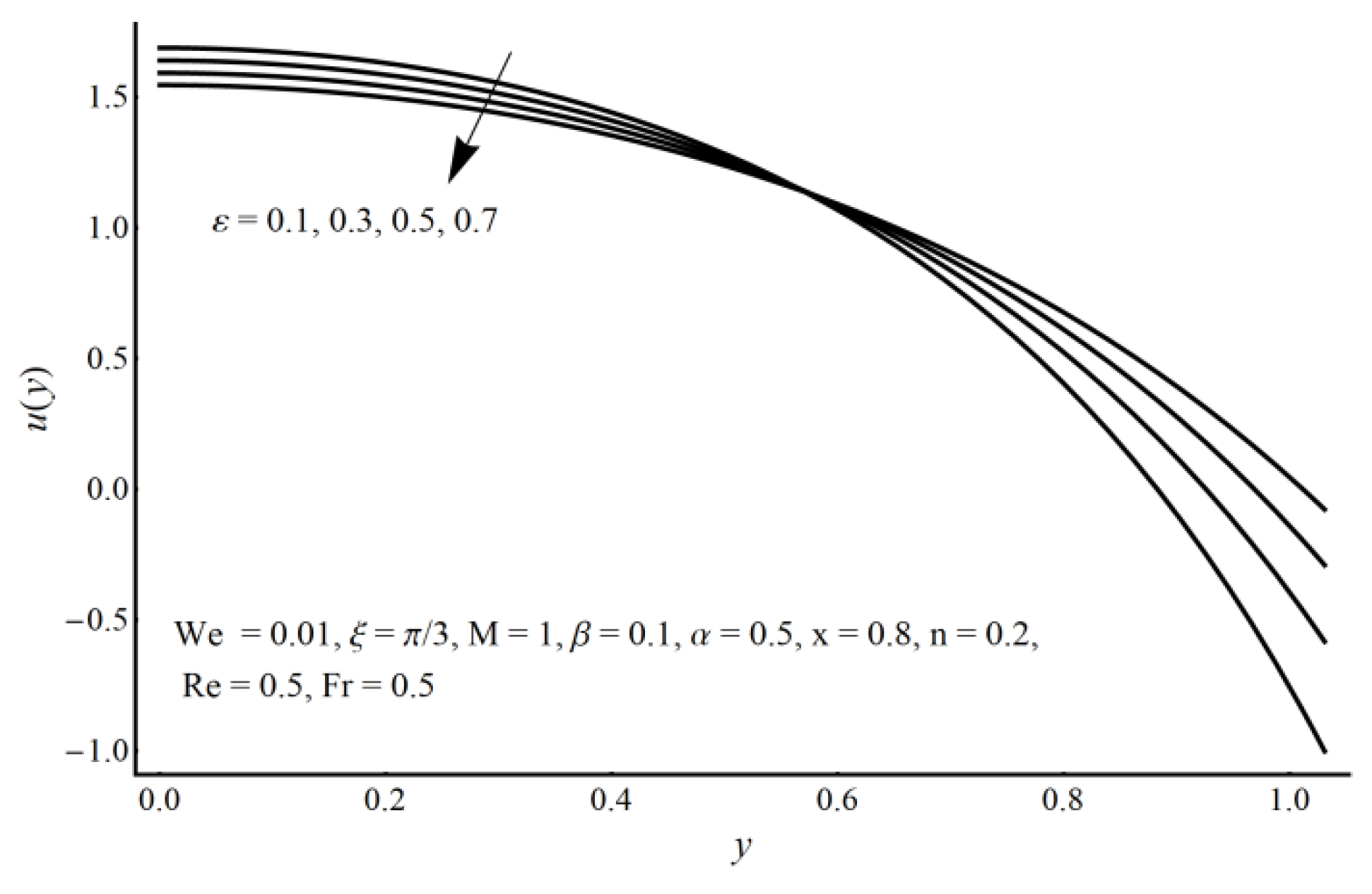
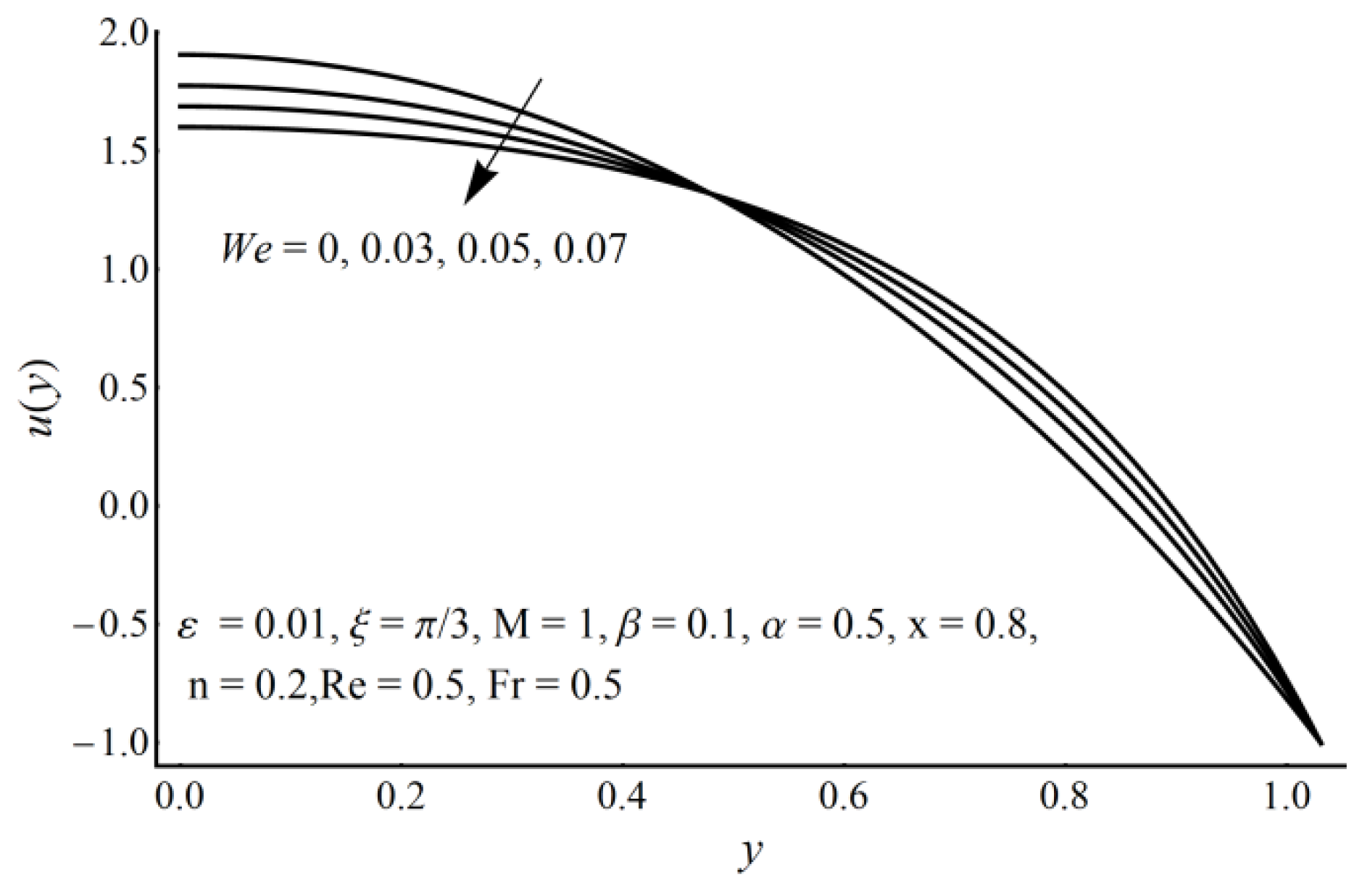
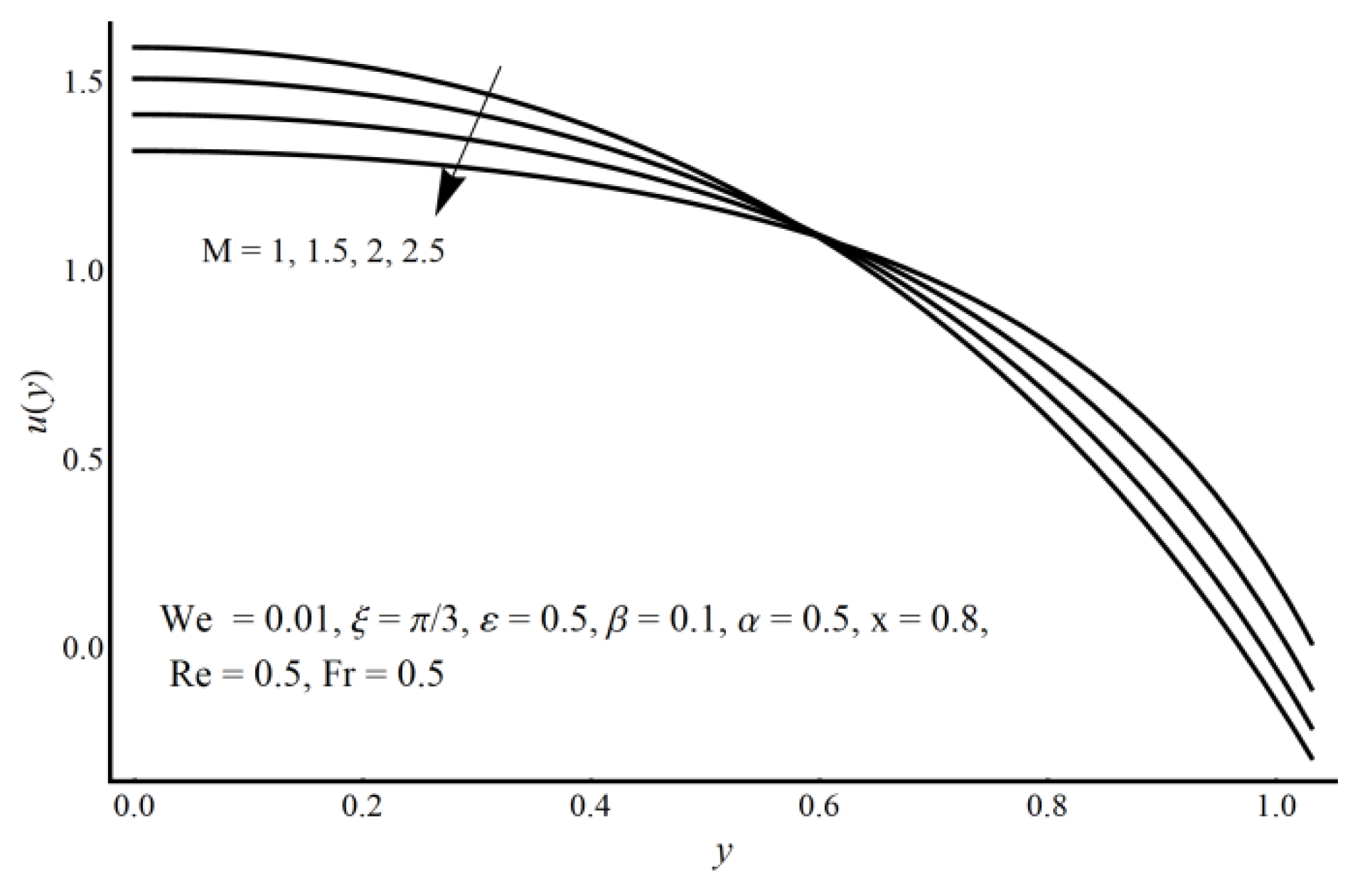
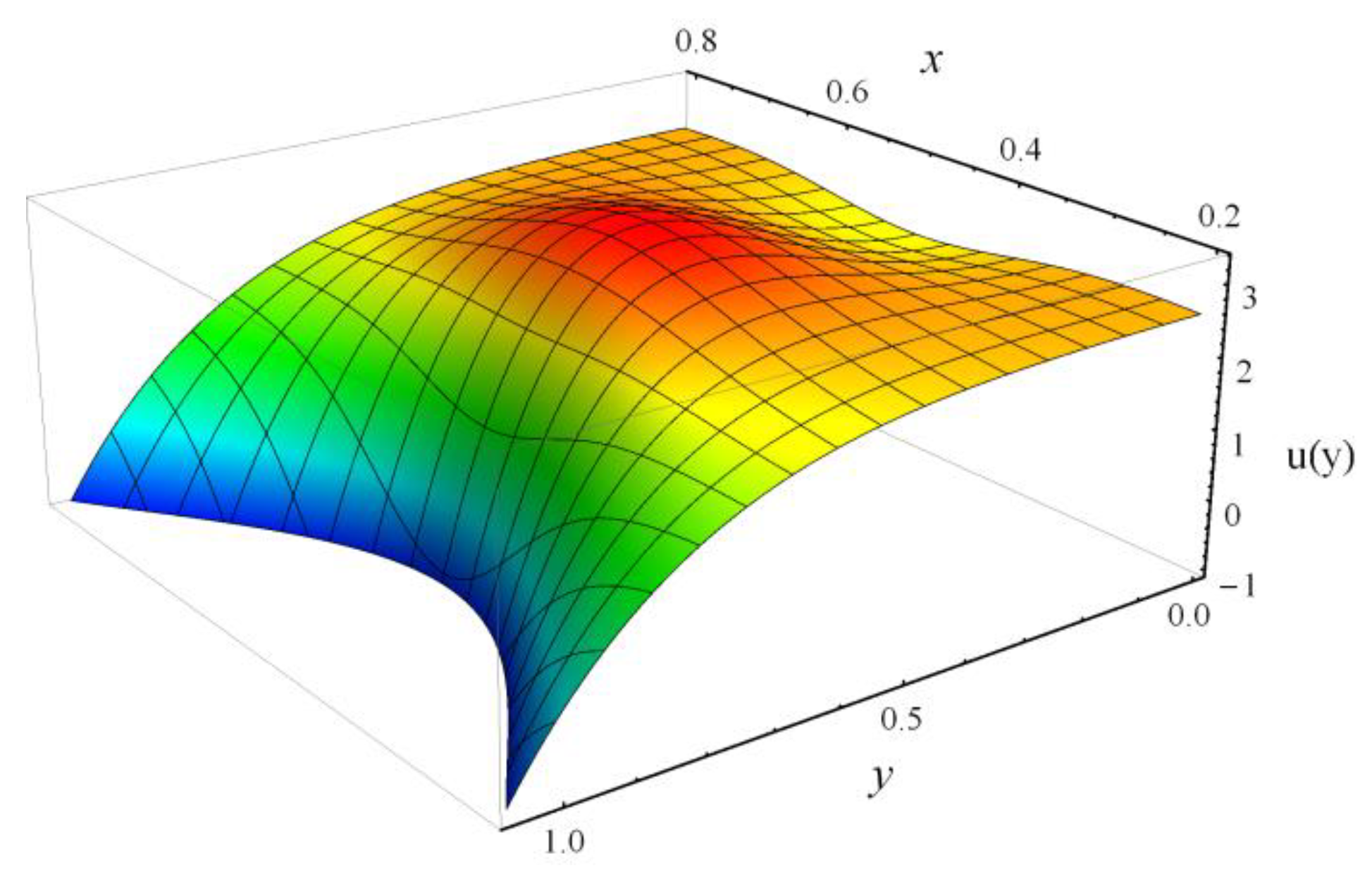
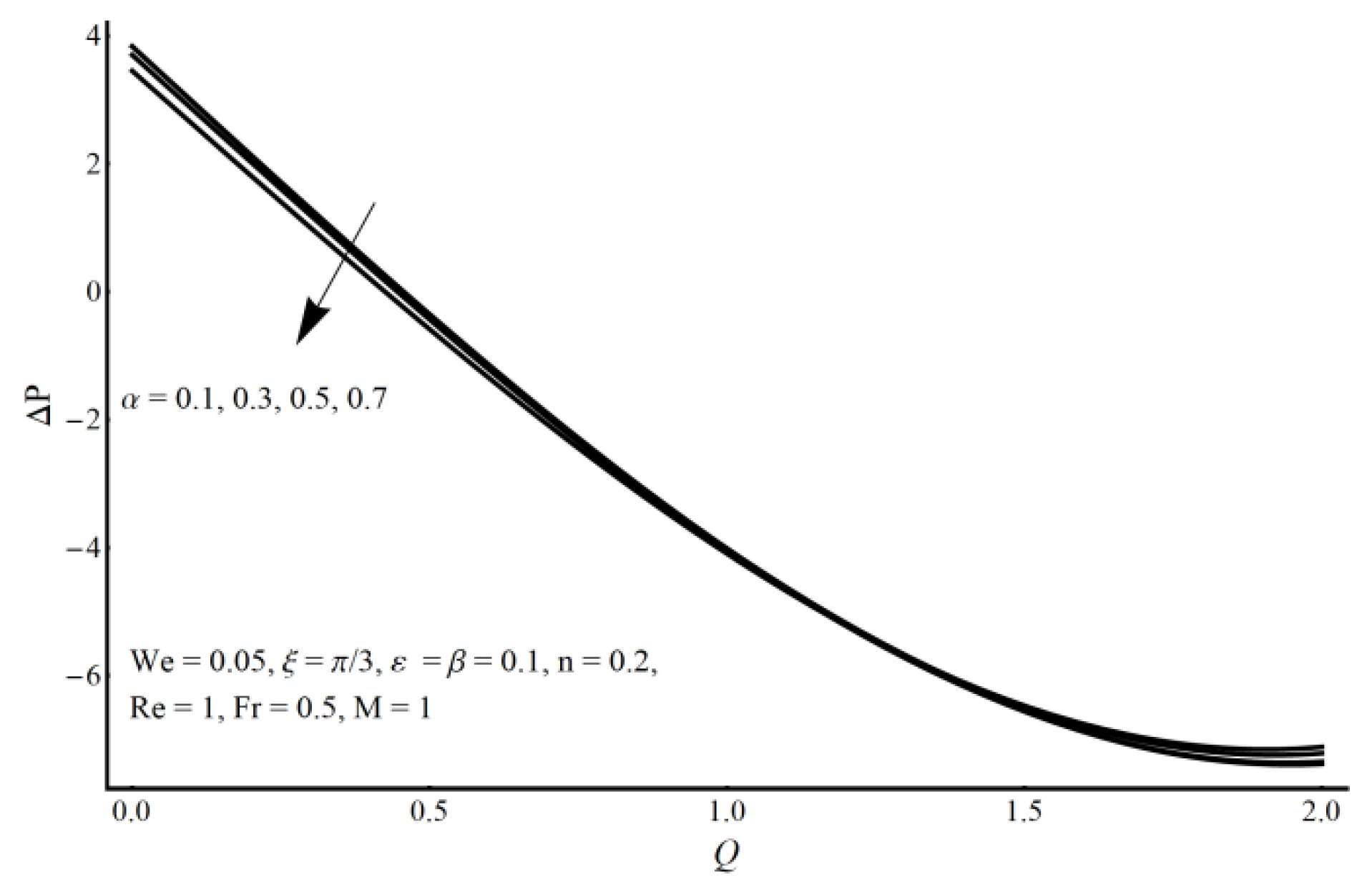
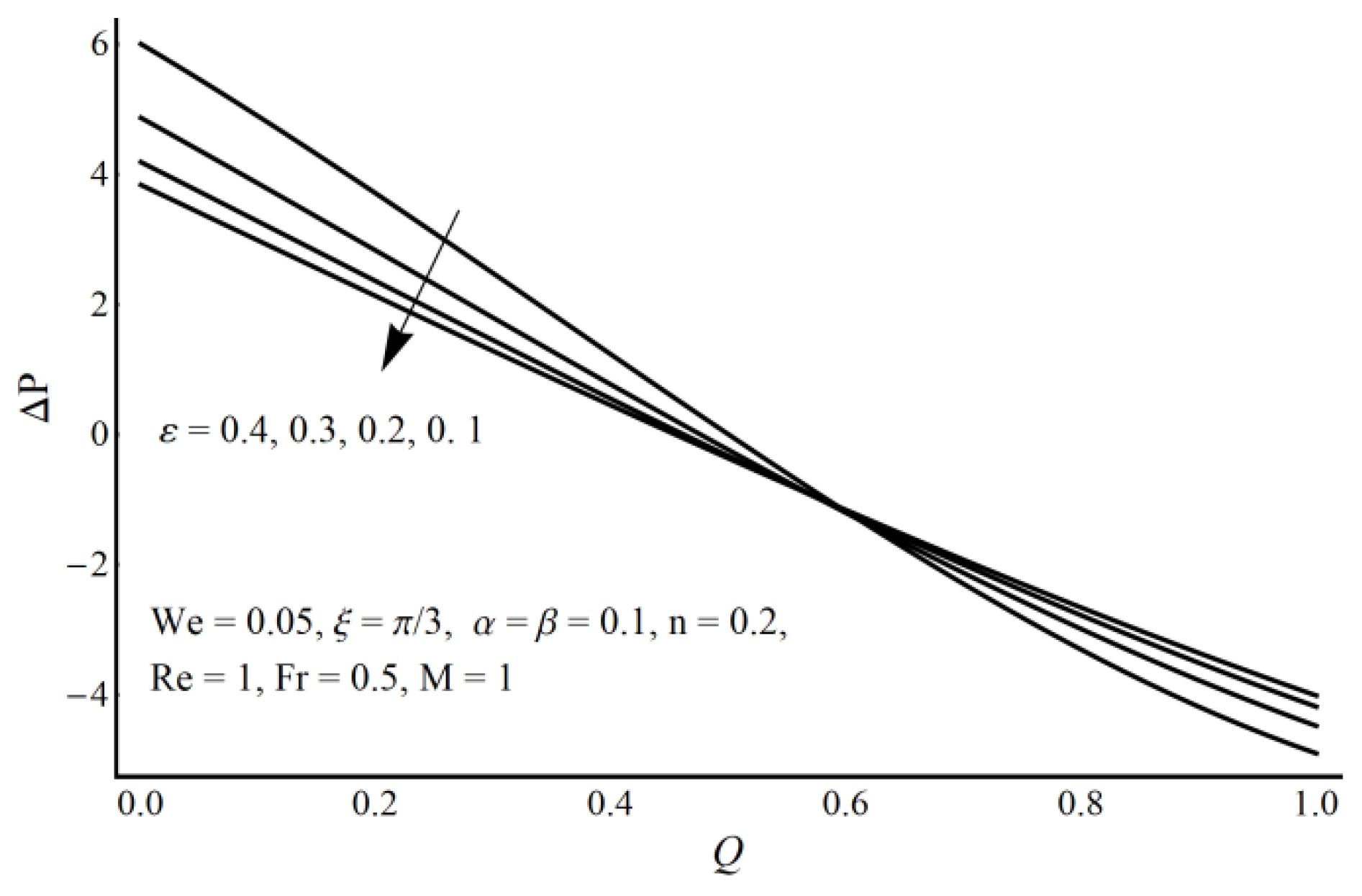
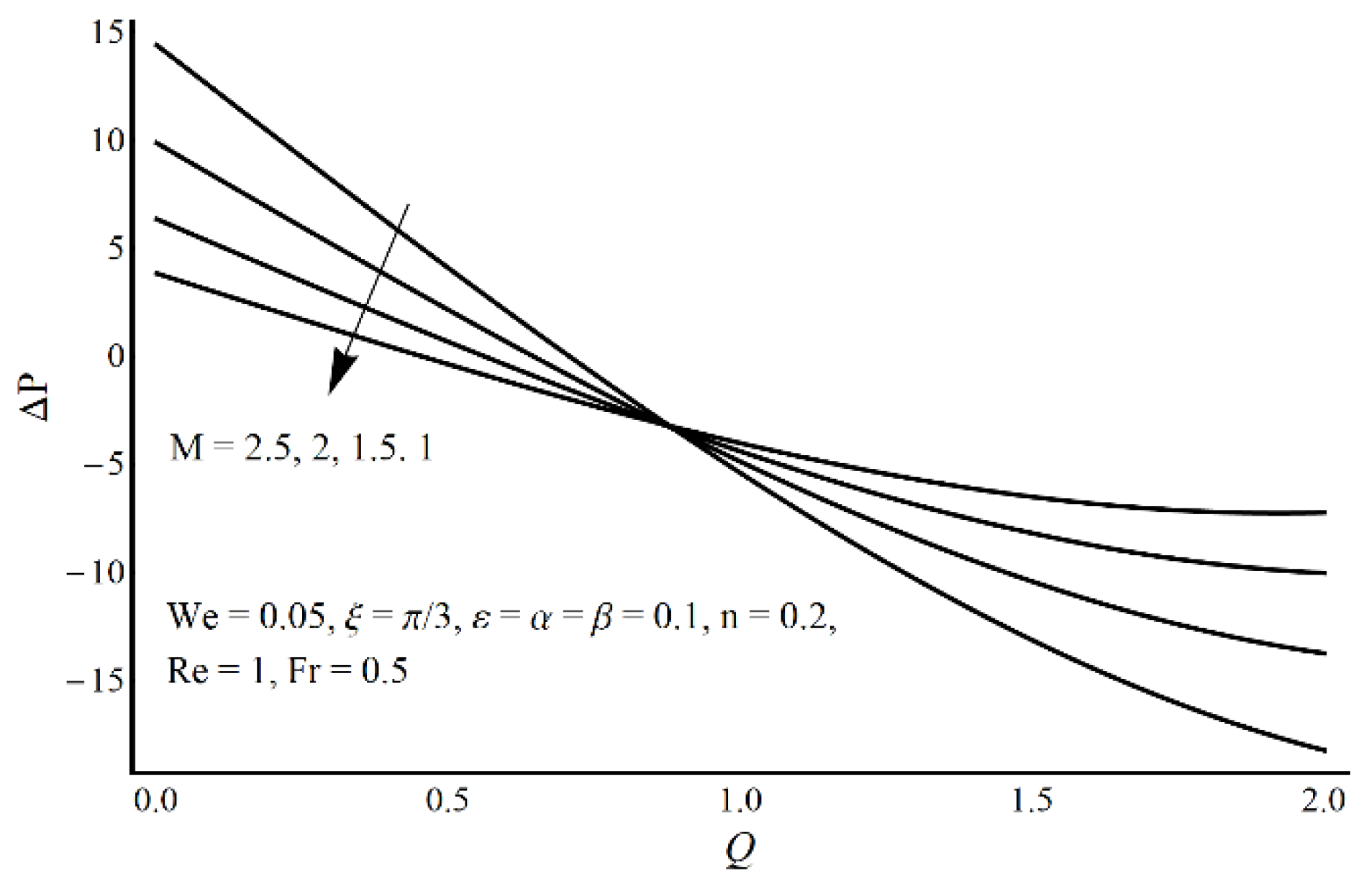
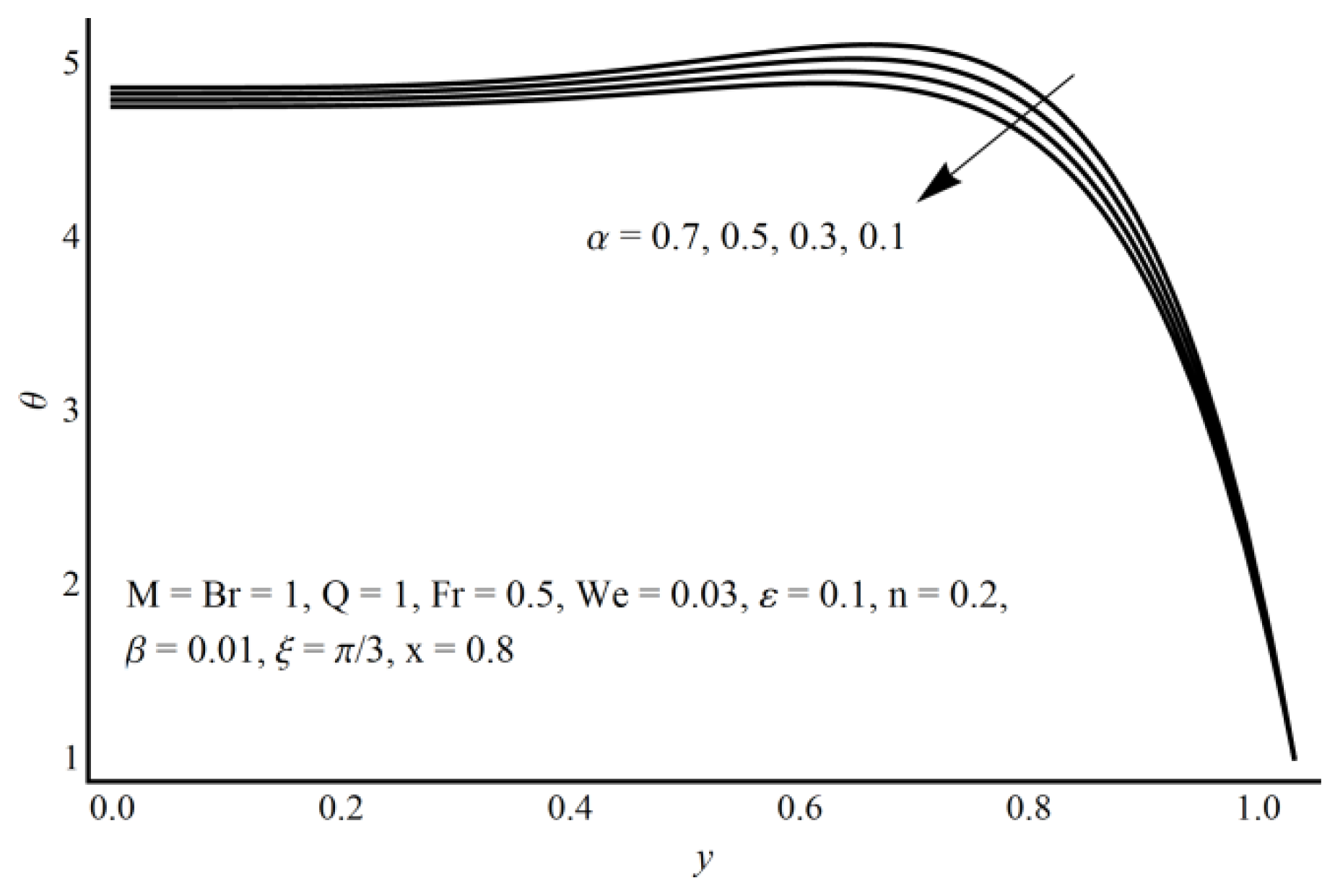

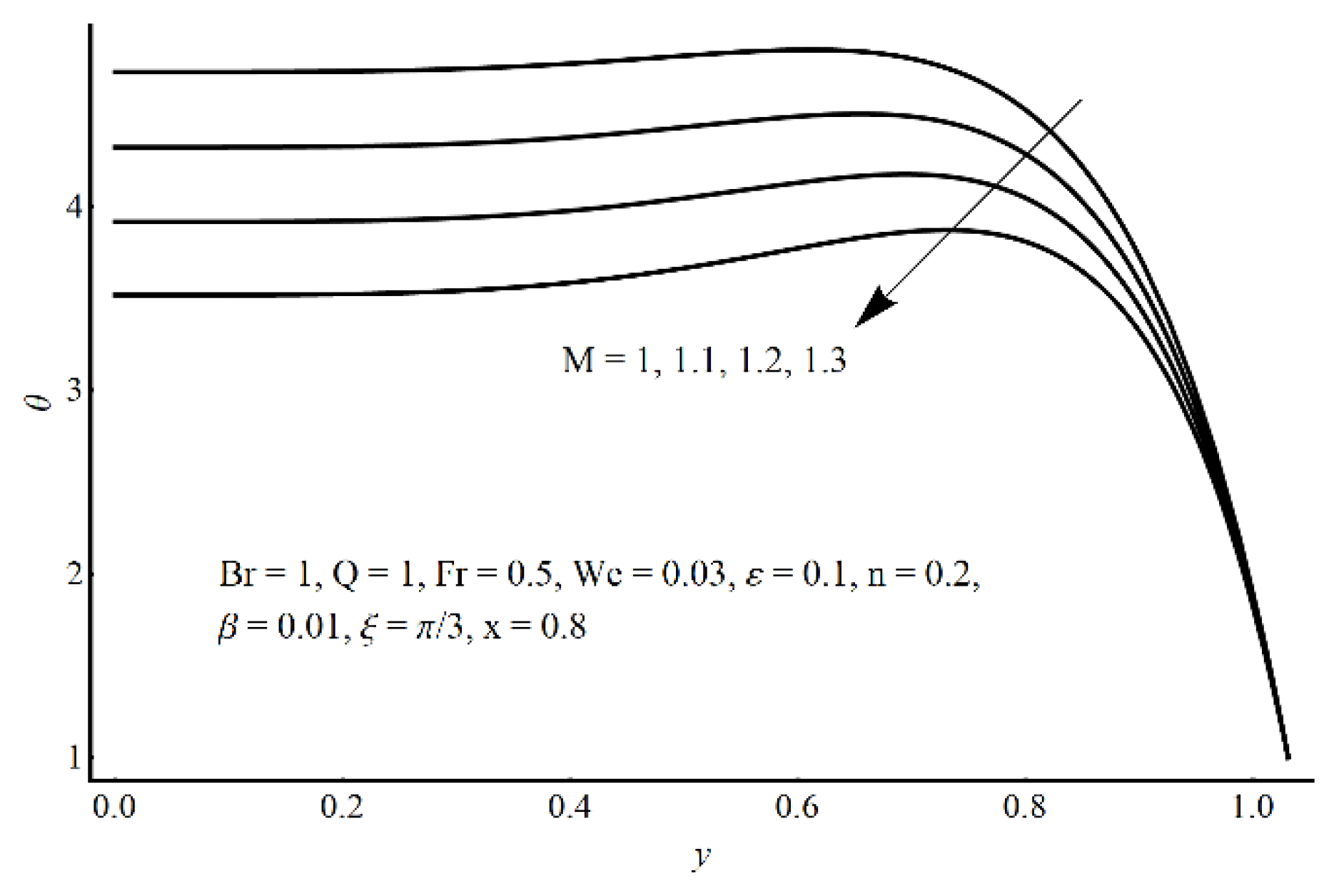
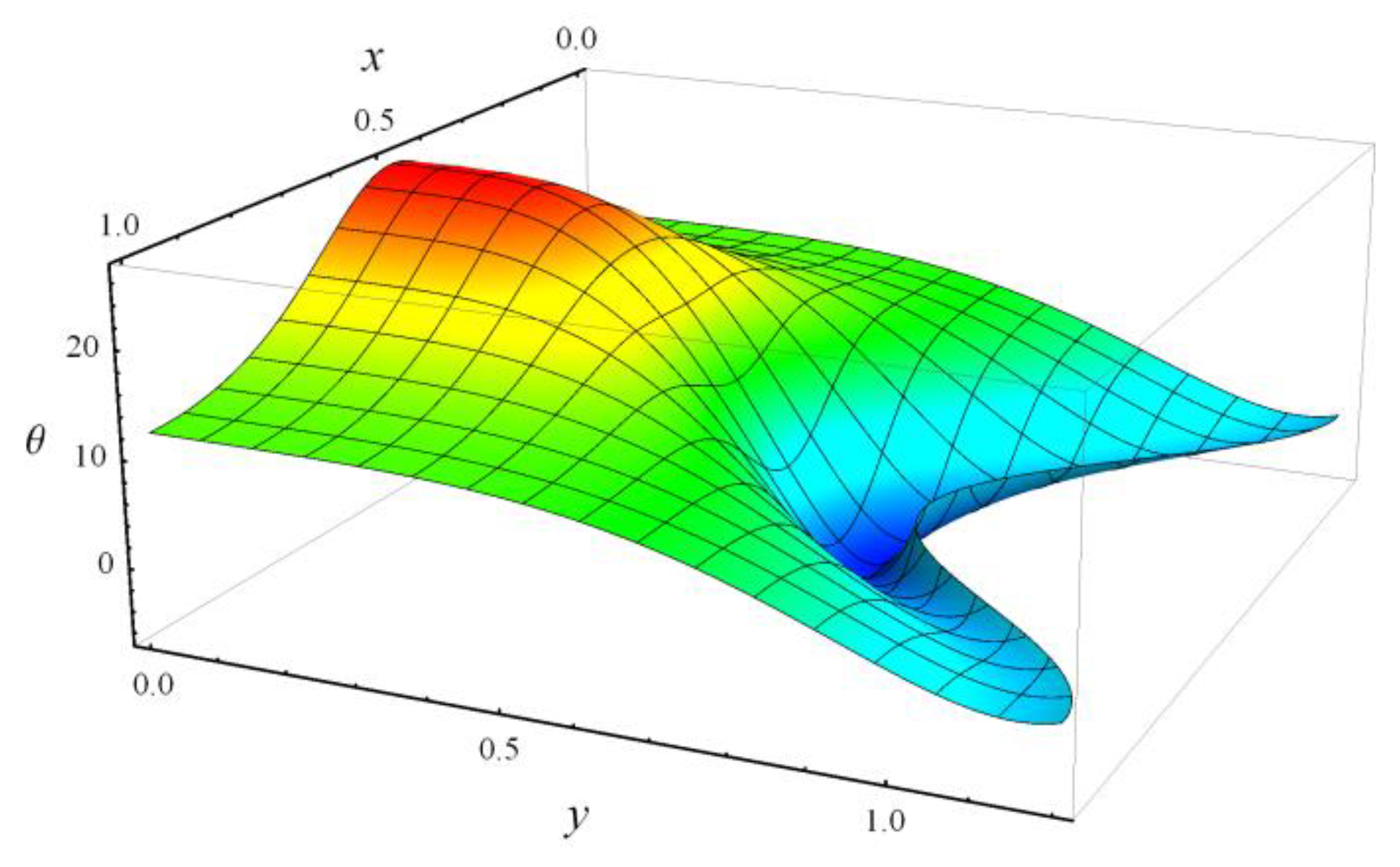

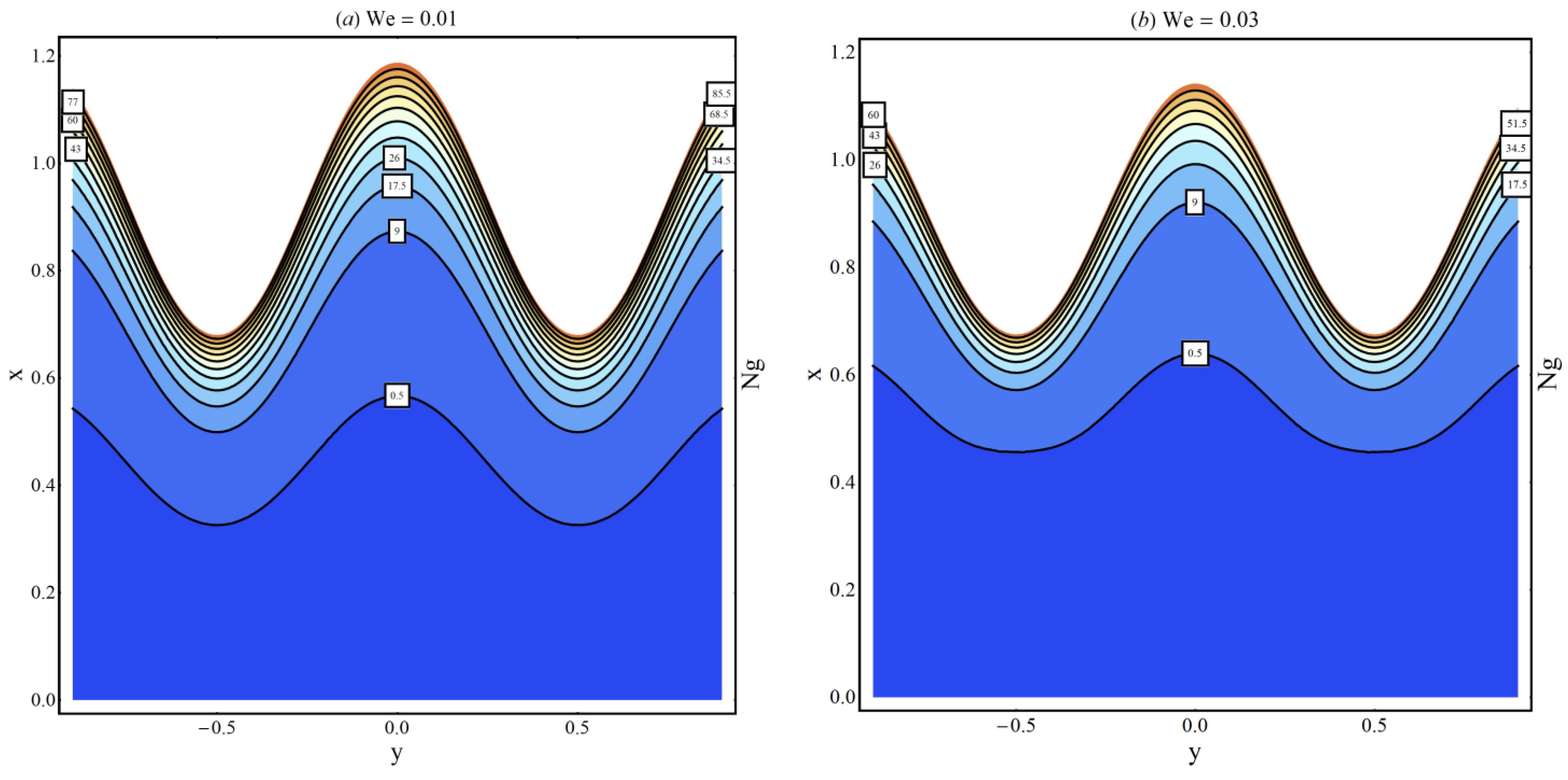
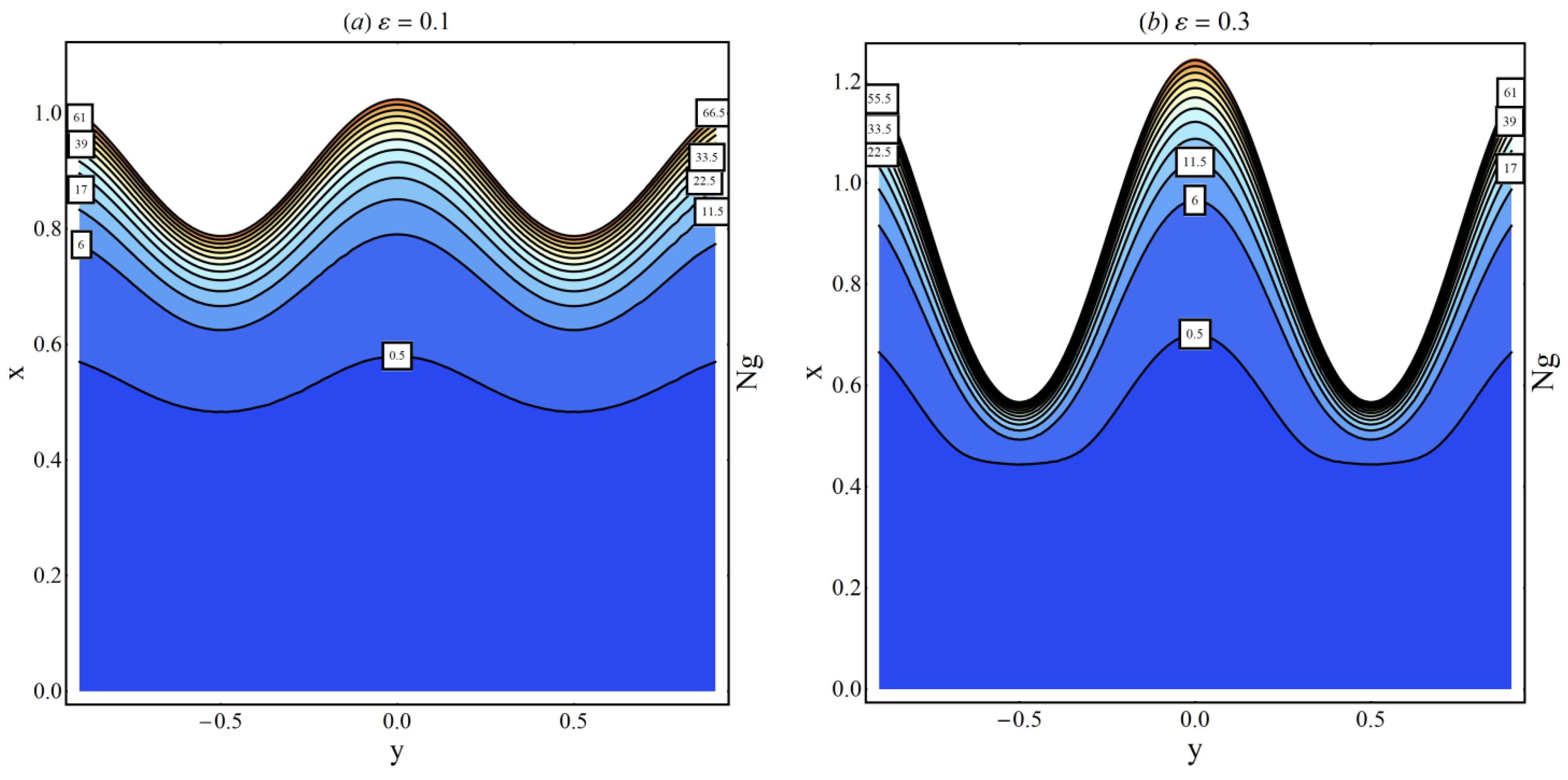
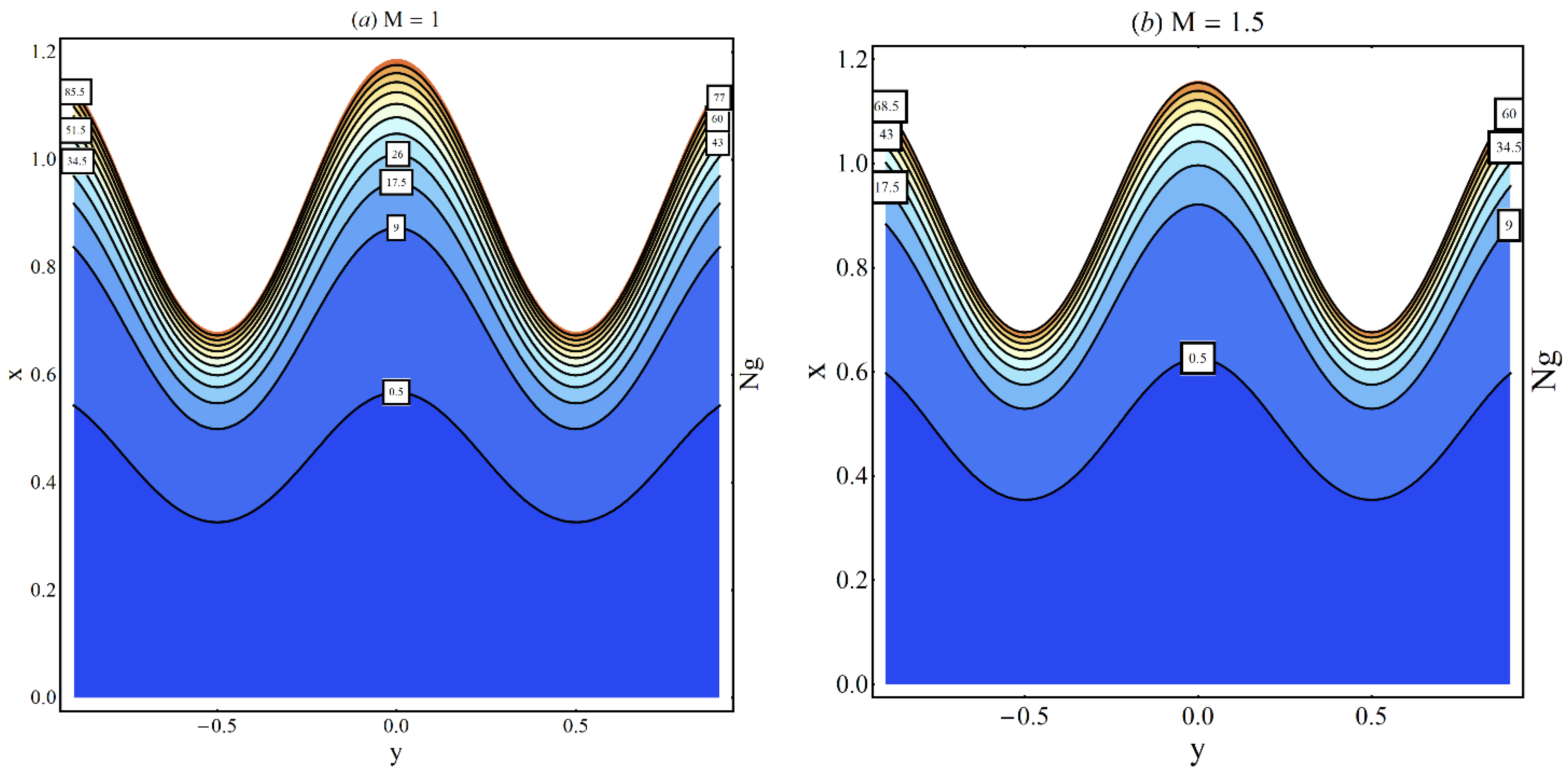
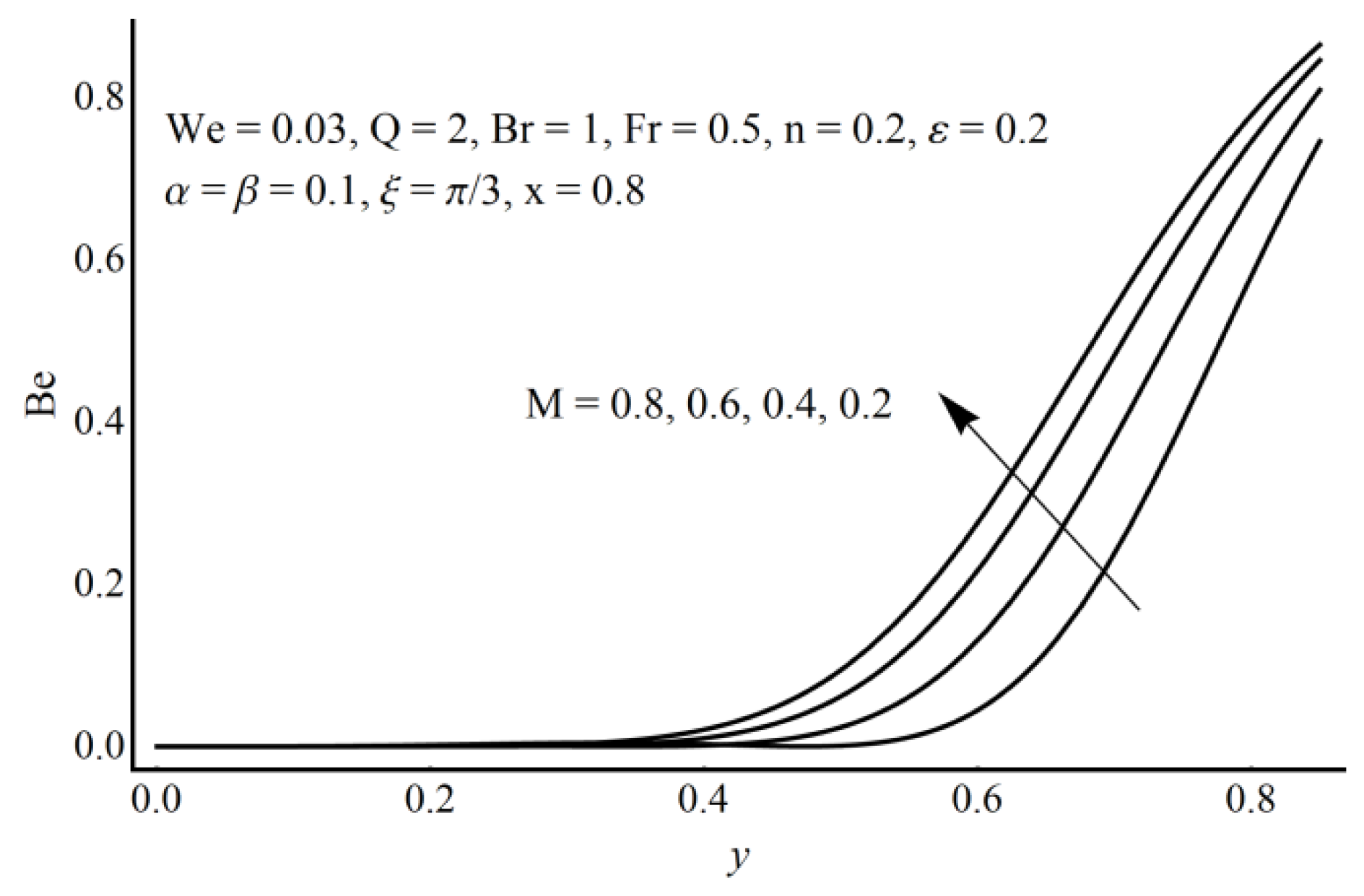
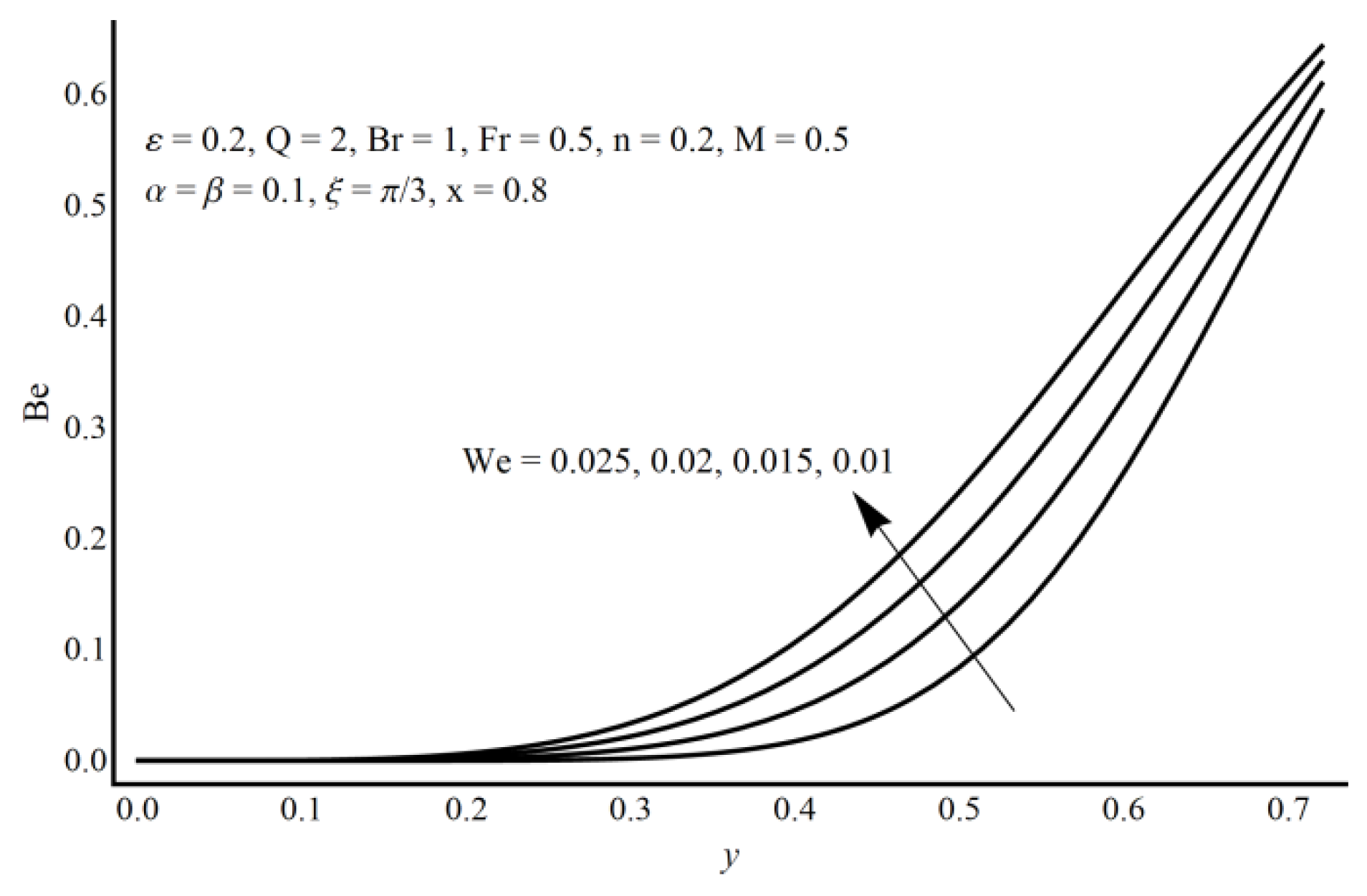
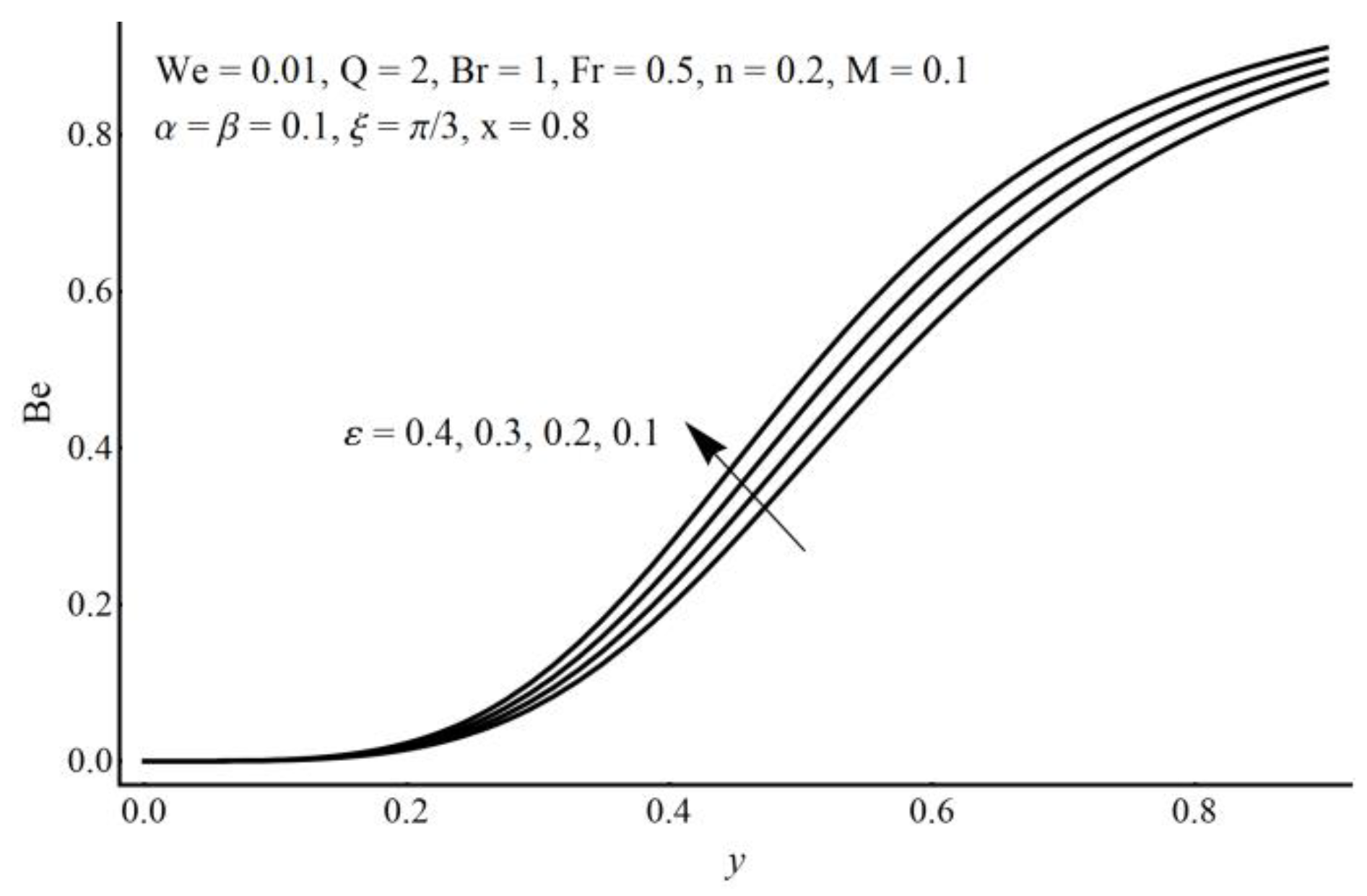
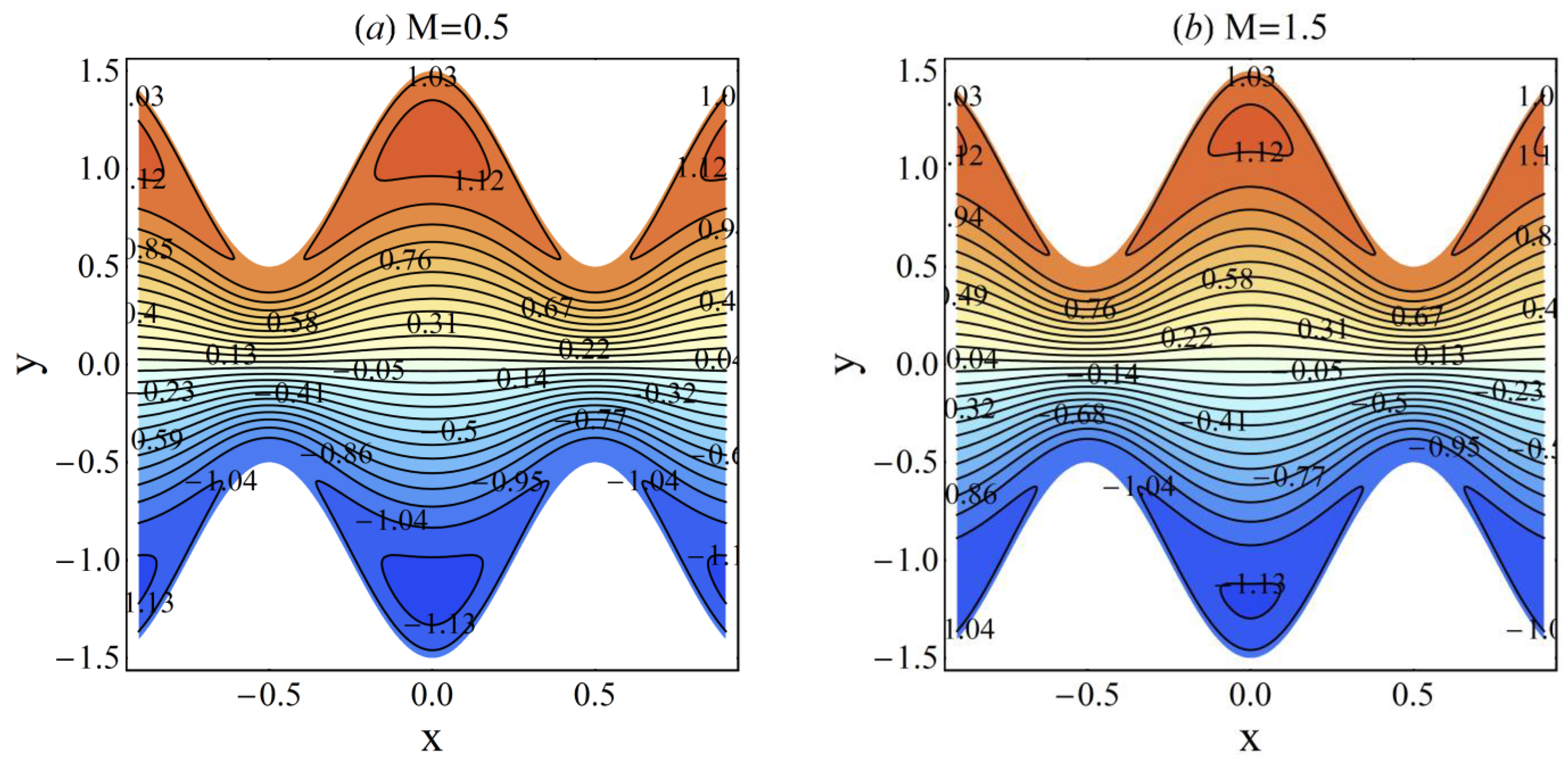
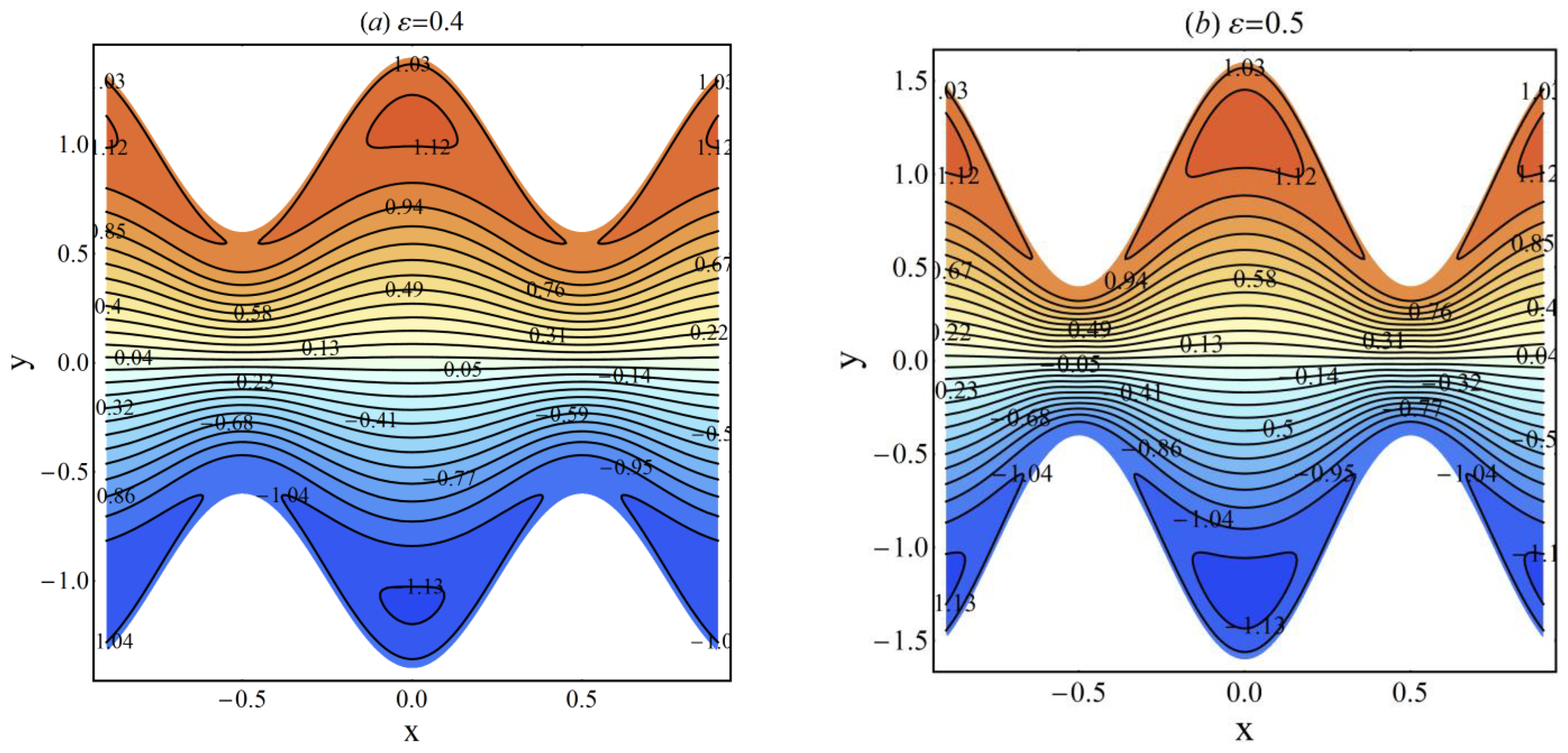

| n | u′(h) (Analytic) | u′(h) (Numerical) |
|---|---|---|
| 0 | −12.885 | −12.868 |
| 0.2 | −12.876 | −12.866 |
| 0.4 | −12.867 | −12.860 |
| 0.6 | −12.859 | −12.848 |
| 0.8 | −12.854 | −12.846 |
© 2020 by the authors. Licensee MDPI, Basel, Switzerland. This article is an open access article distributed under the terms and conditions of the Creative Commons Attribution (CC BY) license (http://creativecommons.org/licenses/by/4.0/).
Share and Cite
Munawar, S.; Saleem, N. Second Law Analysis of Ciliary Pumping Transport in an Inclined Channel Coated with Carreau Fluid under a Magnetic Field. Coatings 2020, 10, 240. https://doi.org/10.3390/coatings10030240
Munawar S, Saleem N. Second Law Analysis of Ciliary Pumping Transport in an Inclined Channel Coated with Carreau Fluid under a Magnetic Field. Coatings. 2020; 10(3):240. https://doi.org/10.3390/coatings10030240
Chicago/Turabian StyleMunawar, Sufian, and Najma Saleem. 2020. "Second Law Analysis of Ciliary Pumping Transport in an Inclined Channel Coated with Carreau Fluid under a Magnetic Field" Coatings 10, no. 3: 240. https://doi.org/10.3390/coatings10030240
APA StyleMunawar, S., & Saleem, N. (2020). Second Law Analysis of Ciliary Pumping Transport in an Inclined Channel Coated with Carreau Fluid under a Magnetic Field. Coatings, 10(3), 240. https://doi.org/10.3390/coatings10030240






